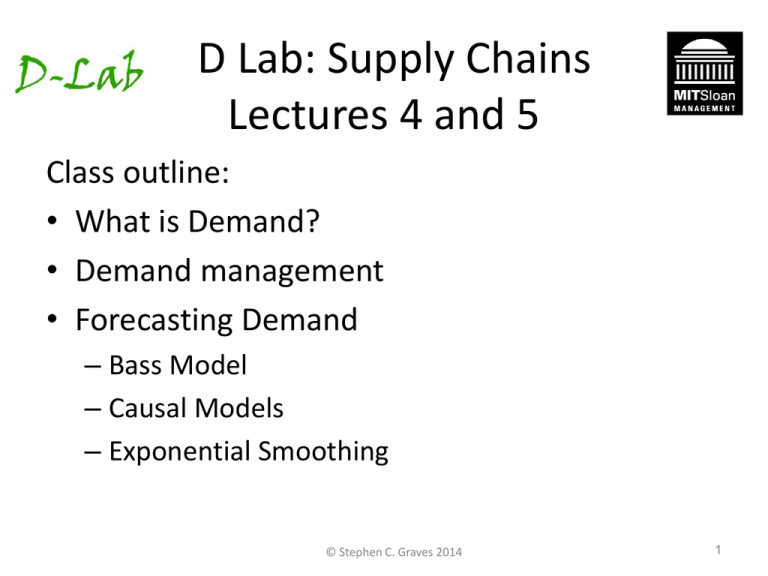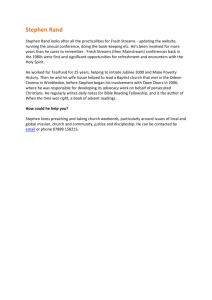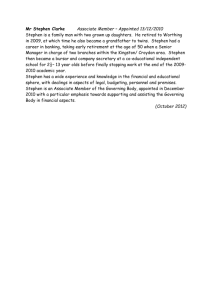
D Lab: Supply Chains
Lectures 4 and 5
Class outline:
• What is Demand?
• Demand management
• Forecasting Demand
– Bass Model
– Causal Models
– Exponential Smoothing
© Stephen C. Graves 2014
1
ARTI
Sinead Cheung
Neha Doshi
Emily Grandjean
Shannon Kizilski
Cherry Park
Sanjana Puri
Jessica Shi
Spencer Wenck
Chelsea Yeh
Daniel
Air Liquide Wecycler Ghonsla
1
BPS
1
1
1
2
2
1
1
1
1
© Stephen C. Graves 2014
2
Who is Alex Rogo? If you don’t know, it means you are not reading
“The Goal”…
© Stephen C. Graves 2014
3
Assignment: Next Monday
• Book Review
This assignment is due at the beginning of class.
Prepare a one page summary of The Goal formatted
as follows:
1. List your (at most) 5 main take-aways from the
book (at most 2-3 sentence each); and
2. List the (at most) 3 main critiques (at most 2-3 sentence each) you would make about this book
© Stephen C. Graves 2014
4
Demand Management
© Stephen C. Graves 2014
5
Demand Management
© Stephen C. Graves 2014
6
What is demand?
From the Merriam-Webster dictionary,
Demand is the quantity of a commodity or service wanted at a specified price and time. •How can we deal with demand from a SC
point of view?
•Why is anticipating demand important?
© Stephen C. Graves 2014
7
Why forecast? - Two SC strategies
Two supply chain strategies for dealing with
demand are
•Make-to-order (MTO): the company chooses
to manufacture a product only after a request
from a customer is received.
•Make-to-stock (MTS): based on forecasts
production is done in anticipation of future
demand.
© Stephen C. Graves 2014
8
Two SC strategies - Examples
Make-to-order (MTO)
• Construction Industry
• Customized products
• Services/Food
Make-to-stock (MTS)
• Vaccines and medicine
• Most consumer goods
• Agricultural Products
More examples?
© Stephen C. Graves 2014
9
Two SC strategies - Tradeoffs
MTS
Economies of Scale
✔
More dependent on demand
forecasts
Longer lead time for customers
✔
Easier to scale-up
✔
MTO
✔
Customizable products
✔
Forecasting is important for both models
© Stephen C. Graves 2014
10
Two SC strategies - Emerging Markets
In the context of emerging markets, think about the
following question:
Can you give examples of products for which a MTO model
“makes sense” in a developed economy but not in an
emerging economy?
© Stephen C. Graves 2014
11
More reasons why forecasting is important
•Forecast used for inventory planning at retail
store level and at DC level for products held in
stock (ie, MTS)
•Forecast used to determine when to order
more inventory
•Need for simple, robust methods applicable
for wide range of contexts
© Stephen C. Graves 2014
12
Forecast principles
Value
1. Forecasts are always wrong and should always
include some measure of error
2. The longer the horizon, the larger the error
3. Method should be chosen based on need and
context
Now
© Stephen C. Graves 2014
Time
13
Forecasting – formal definition
Previous observations of demand
Additional info:
Forecast
System Model
Forecast period
© Stephen C. Graves 2014
14
Forecasting – formal definition
Previous observations of demand
Additional info:
Forecast
Forecast period
How would you forecast seminar lunch boxes?
© Stephen C. Graves 2014
15
Factors for choosing forecast method
• How is forecast to be used? Need for accuracy?
Units? Time period? Forecast horizon? Frequency of
revision?
• Availability and accuracy of relevant data? censored?
• Computational complexity? Data requirements?
• How predictable is the entity? Are there independent
factors that affect it or are correlated to it?
• Level of aggregation? Across geographies? Time?
Product categories?
• Type of product? New or old?
© Stephen C. Graves 2014
16
Types of forecasts
•
•
•
•
•
•
Qualitative; expert opinions
Diffusion models
Causal models, eg, regression
Disaggregation of an aggregate forecast
Aggregation of detailed forecasts
Time series methods
© Stephen C. Graves 2014
17
Types of forecasts
Forecasting Methods
New Products
Bass Diffusion Model
Existing products
Time Series Methods
Causal Models
© Stephen C. Graves 2014
18
Forecasting the adoption of new products
© Stephen C. Graves 2014
19
Example: Water Purifier
Assume you are responsible for estimating a
demand for a new cheap and efficient water
purifier. How would you do it?
© Stephen C. Graves 2014
20
The Bass Diffusion Model
•Is a model for adoption of new products
(consumer durables)
•One of the 10 most influential papers of
“Management Science” in the last 50 years
•Widely used in marketing and strategy
•We will build the model from first
principles
Frank Bass
© The University of Texas at Dallas. All rights reserved. This
content is excluded from our Creative Commons license. For
more information, see http://ocw.mit.edu/help/faq-fair-use/.
© Stephen C. Graves 2014
21
The Bass Diffusion Model
Key idea: consumers are divided into 2 groups:
Innovators
• Early adopters
• Not influenced by other
individuals
• Driven by advertisement or some other external effect
Imitators
• Influenced by other buyers
• Word of mouth
• Network effects
© Stephen C. Graves 2014
22
Motivation for the Bass model
Total: N
. . .
Innovators with prob. r
Imitators with prob. 1‐r
. . .
© Stephen C. Graves 2014
23
Innovators
Total: N
Imitators
. . .
Innovators
Probability of adoption =
Imitators
Probability of adoption =
© Stephen C. Graves 2014
24
Innovators
t = 1
Total: N
Imitators
. . .
Innovators
Probability of adoption =
Imitators
Probability of adoption = =0
© Stephen C. Graves 2014
25
t = 2
Total: N
...
Innovators
Probability of adoption =
Imitators
Probability of adoption =
=
© Stephen C. Graves 2014
26
t = 3
Total: N
...
Innovators
Probability of adoption =
Imitators
Probability of adoption =
=
© Stephen C. Graves 2014
27
Motivation (board)
•
•
•
•
•
•
Market size:
Number of new adopters at time t:
Total number of adopters at time t:
Probability of being an innovator:
Probability of an innovator adopting at time t:
Probability of an imitator adopting at time t:
• Define
p pr;
q 1 r q
© Stephen C. Graves 2014
28
Bass Model
• We can approximate the model we just
described by
• The continuous differential equation becomes Innovators
© Stephen C. Graves 2014
Imitators
29
Bass Model
•Thus, for the continuous approximation, we
have, for
, the solution
Imitators
New adopters
Total adoption
Innovators
Time
© Stephen C. Graves 2014
Total
Time
30
Estimation of parameters
• What parameters do we need to estimate?
– Market Size
– Imitation
– Innovation
• How do we estimate?
–
–
–
–
Early data + linear regression
Analogy (priors)
Focus groups
Macro Data
• What is missing?
© Stephen C. Graves 2014
31
Generalized Bass Model
• Let “marketing effort” evolve as x(t). The new equation is: • When estimating or doing focus groups, try to map price vs. demand group
• Create a model for different prices
© Stephen C. Graves 2014
32
Bass Model Examples © Stephen C. Graves 2014
33
DIRECTV
• Launched in 1992
• How many people would subscribe to satellite
TV and when?
• New technology
• p and q were estimated by analogy
• N was determined by market research and
focus groups
© Stephen C. Graves 2014
34
DIRECTV
© Stephen C. Graves 2014
35
Fitting the Bass Model
The Bass difference equation is We can fit this equation to the data!
© Stephen C. Graves 2014
36
Causal Models
© Stephen C. Graves 2014
37
Example – Dengue in India
• Dengue is transmitted by a
mosquito, the Ades Aegypti
• During Summer monsoon,
stagnant water accumulates
© source unknown. All rights reserved. This content is excluded from our Creative
Commons license. For more information, see http://ocw.mit.edu/help/faq-fair-use/.
• This leads to a proliferation of
mosquito reproduction
• A increase in mosquitos
increases dengue transmission
During rainy season
there is a lot of
stagnant water
© Stephen C. Graves 2014
38
Example – Dengue in India
• Causal models are very useful to estimate
the occurrence of weather related
diseases (and the demand for
medicine/vaccines).
• Consider the relationship between monthly
rainfall and the occurrence of Dengue
Fever in India
© Stephen C. Graves 2014
39
Google Dengue Index
0.8
0.0
500
0.2
0.4
0.6
1000 1500 2000 2500 3000
Rainfall
Dengue Index
0
Rainfall (mm/month)
Example – Dengue in India
2004
2006
2008
Time - Years
2010
The index is an estimate by Google.org of Dengue Activity.
© Stephen C. Graves 2014
40
Causal Models
Can you think of other examples? © Stephen C. Graves 2014
41
Types of forecasts Forecasting Methods
New Products
Bass Diffusion Model
Existing products
Time Series Methods
Causal Models
© Stephen C. Graves 2014
42
Time Series Methods
• Used when there is limited information
available about exogenous factors that
influence demand
• Short horizon forecast (usually < 1 year)
• We will discuss methods that are easy to
implement
© Stephen C. Graves 2014
43
Time Series – Components of Demand
In practice, it is useful to understand and estimate 4
components of demand: mean, trend, seasonality
and randomness.
© Stephen C. Graves 2014
44
Randomness • Usually modeled using probability
distributions
• Two components: mean and variance
– Mean: Average Value
– Variance: “spread”
© Stephen C. Graves 2014
45
Time Series Methods
Assume demand has the form
10
Randomness
© Stephen C. Graves 2014
-5
-10
In addition, assume that
Mean:
Variance:
0
5
Permanent component:
Mean, trend, seasonality
0
20
40
60
80
Randomness
46
100
Time Series Methods
Assume demand has the form
In addition, assume that
Forecast method determines
: Expost estimate of the permanent
component
: forecast at time
© Stephen C. Graves 2014
47
Time Series Methods
• What is permanent component and expost
estimate?
Expost estimate is where we “think” that the
permanent component is in the time period
• We are ready to discuss forecasting
methods
© Stephen C. Graves 2014
48
Moving Average
• Recent observations are more “informative”
than old observations
• Uses n previous observations
• Expost estimate of the permanent
component
is
• Forecast is © Stephen C. Graves 2014
49
Moving Average
• Advantages: Simple, only one “knob” (n)
• Disadvantages: weighs all previous
demand equally
• Example
© Stephen C. Graves 2014
50
Weighted Moving Average
• Weighs previous observations using
weights
where
• We have the expost estimate
and the forecast (again) is
© Stephen C. Graves 2014
51
Weighted Moving Average
• Advantages: Flexibility
• Disadvantages: too many “knobs” • Solution: Exponential Smoothing © Stephen C. Graves 2014
52
Exponential Smoothing
• Weighs previous observations using a
geometric time series such that
Note that
Thus,
© Stephen C. Graves 2014
53
Exponential Smoothing
• Only one parameter to adjust • Doesn’t weigh previous forecasts equally
• Very simple update equation
• Examples
© Stephen C. Graves 2014
54
Exponential Smoothing vs. Moving Average
• Assume permanent component is constant
• For exponential smoothing:
,
• For moving average
,
© Stephen C. Graves 2014
55
Holt-Winters Method
• So far, we did not explicitly estimate
seasonality or trend
0
10
• Assume that the permanent component is
Seasonality
-20
-10
-5
-15
0
-10
5
-5
Trend
0
20
40
60
© Stephen C. Graves 2014
80
100
0
20
40
60
80
100
56
Holt-Winters Method
• So far, we did not explicitly estimate
seasonality or trend
• Assume that the permanent component is
• Demand is © Stephen C. Graves 2014
57
Holt-Winters Method
• Assume we know that the length of a
season is L
• Let be the deseasonalized
permanent component
• We now need to estimate,
Idea: Exponential smoothing on all the parameters!
© Stephen C. Graves 2014
58
Expost Estimates
• Deseasonalized demand
• Trend
• Seasonal factor
© Stephen C. Graves 2014
59
Expost Estimates
Deseasonalized demand
Where we think the
deaseason. permanent
component will be
© Stephen C. Graves 2014
60
Expost Estimates
Deseasonalized demand
Deaseasonalized demand
© Stephen C. Graves 2014
61
Expost Estimates
Deseasonalized demand
Trend
© Stephen C. Graves 2014
62
Expost Estimates
Deseasonalized demand
Trend
Smoothing coefficient
© Stephen C. Graves 2014
63
Expost Estimates
Deseasonalized demand
Trend
Estimate of slope
© Stephen C. Graves 2014
64
Expost Estimates
Deseasonalized demand
Trend
Seasonality © Stephen C. Graves 2014
65
Expost Estimates
Deseasonalized demand
Trend
Seasonality
Another smoothing coef.
© Stephen C. Graves 2014
66
Expost Estimates
Deseasonalized demand
Trend
Seasonality
Another smoothing coef.
© Stephen C. Graves 2014
67
Expost Estimates
Deseasonalized demand
Trend
Seasonality
Seasonality factor
© Stephen C. Graves 2014
68
Forecast
• Given
• The forecast is
© Stephen C. Graves 2014
69
Holt-Winters Method
Get new
data
Update X
Update C
Update B
© Stephen C. Graves 2014
70
Wrap-up
Variables
Info
Moving Average
none
Weighted moving Average
none
Exponential Smoothing
none
Holt-Winters
© Stephen C. Graves 2014
71
MIT OpenCourseWare
http://ocw.mit.edu
15.772J / EC.733J D-Lab: Supply Chains
Fall 2014
For information about citing these materials or our Terms of Use, visit: http://ocw.mit.edu/terms.




